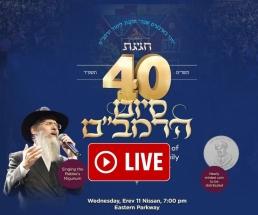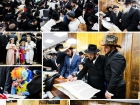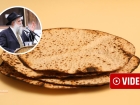The “Cheder” That Accepted Grown Men — Who Knew The Entire Shas
From Beis Moshiach Magazine: For 24 Teves, the Yom Hilula of the Alter Rebbe, we present a historical overview of the Alter Rebbe’s famous “Chadarim” – a yeshiva-like institution of three levels to which the Alter Rebbe accepted his early Chassidim who were outstanding geonim in their own right • These Cheder students, in turn, became the “supers spreaders” of Chassidus in Lithuania and White Russia • Full Article
By Zalman Berger, Beis Moshiach Magazine
Not many are familiar with the first chapter in the history of Chabad, namely the “chadarim” established by the Alter Rebbe. It was these chadarim, which we would call ‘yeshiva’ and ‘kollel’ today, that were the nucleus for the Chabad Chassidic movement. These chadarim were revolutionary when it came to the study and dissemination of Chassidus.
They were hundreds of young men who chose to disengage from the affairs of this world and immerse themselves in the study of Nigleh and Chassidus under the close guidance of the Alter Rebbe. These men, being prodigious geniuses who had learned Gemara and Halacha for years to an outstanding level of proficiency, now delved deeply into the new teachings of Chassidus and were given direction in the ways of Chassidus and the Chassidim.
The first and authentic descriptions of the chadarim started by the Alter Rebbe were written as a special letter that the Rebbe Rayatz sent to his son-in-law, Ramash, under the heading, “Avos HaChassidus,” and was published ninety years ago.
In this brief article we will focus on the description of the chadarim and their founding. In order to set a timeline for the founding of the chadarim, we will note the Rebbe’s comment in Sefer HaMaamarim 5711:
“Apparently there were three general time periods in the development of the chadarim:
5533 – (after the passing of the Maggid of Mezeritch).
5536 – when the Alter Rebbe was formally crowned as Nasi of Lithuania.
5538 – when he returned after accompanying Rabbi Menachem Mendel Horodoker when the latter moved to Eretz Yisrael.
The chadarim were divided by level: cheder alef, cheder beis and cheder gimmel. There is also a version that says cheder dalet and cheder hei. Cheder alef was the highest level.
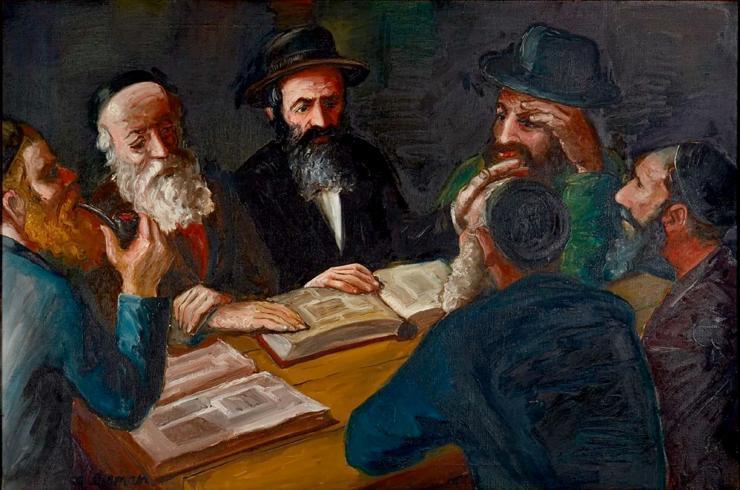


Chassidim learning Torah, drawn by Zalman Kleinman
The Founding
It was some time after the passing of the Mezeritcher Maggid in 5533. The Alter Rebbe took responsibility for spreading Chassidus among the Jews of White Russia and Lithuania.
He quickly brought the teachings of Chassidus to thousands of Jews with his new approach: Chabad. Many flocked to Liozna, to the Rebbe’s court, in order to hear Torah from him. The Alter Rebbe’s reputation as a genius spread quickly and many men came to learn from him.
At first, these were men who lived in towns near Liozna who went to the Rebbe’s court and learned according the curriculum set by the Rebbe. This was the beginning, when R’ Shneur Zalman’s light was just starting to shine in the Jewish world. One could say that in this era, the Rebbe was not yet officially the Rebbe but more like a Torah leader who drew to him those who were seeking to drink from his Torah.
There aren’t many details about the chadarim in this period. Just three years later, in 5536, the chadarim took on a more established, organized form.
It was 5536 when students of the Maggid of Mezeritch, giants of spirit, convened and decided that Rabbi Menachem Mendel of Horodok would travel to Eretz Yisrael and the Alter Rebbe would be appointed as the Nasi of the Chassidim in Lithuania. The expression used was “Mesader Klali,” i.e. leader of the Chassidim.
That year, an announcement was sent out in the name of the Alter Rebbe that men who were supported by their fathers or fathers-in-law could come to Liozna for two to three months in order to be given a system of learning as the Rebbe had innovated.
The Alter Rebbe saw to room and board for the men who came to Liozna. In the announcement it was explained that in light of the Alter Rebbe’s directive, the Jews of Liozna had to provide places to eat and sleep for those who would come. Liozna in those days was under Polish rule and Polish Jews were relatively established financially and would be able to undertake the financial burden of the large-scale hosting.



The tziyun of the Alter Rebbe in Haditch
The Rebbe’s unique initiative became known far and wide and about forty men came from Vitebsk, Beshenkowitz, Horodok, Yanovitch, Rudnia, Kalisk, Lubavitch, Nevel, etc.
The Alter Rebbe did not run the chadarim on his own; he had his distinguished brothers at his side: Rabbi Yehuda Leib (Maharil), Rabbi Mordechai and Rabbi Moshe. All three were known for their genius. It seems that the three of them had learned together in the years prior to the founding of the chadarim. The Tzemach Tzedek told about their learning together and their genius:
“My revered great-uncle, the gaon Maharil [served as rav in Yanovitch in White Russia and a sefer of his was published, She’eiris Yehuda] was an outstanding halachic decider. In every single sugya that he would learn, even the deepest one, he would find a practical halacha. Aside from his extraordinary knowledge of all four parts of Shulchan Aruch with details of the laws and their sources in Shas Bavli, Yerushalmi and the Rishonim, he would innovate new laws with amazing reasoning that bordered on genius.
“My revered great-uncle, the gaon R’ Mordechai [served as rav in Ursha; his last name was Posner] was amazingly sharp and possessed straight reasoning with amazing depth. When he learned a sugya, he would go from the simple to the complex. He learned every sugya five or six times and he would occasionally innovate novel insights as one climbing from level to level, and his give-and-take was delightful and pleasant.
“My revered great-uncle R’ Moshe [served as rav in Bayev and Rudnia] was an amazing explainer and a mouth that issued forth pearls. When he said any divrei Torah, whether in Nigleh or Chassidus… he would explain the issues with amazing and lofty explanations.”
As mentioned, in the period prior to the chadarim, the three brothers had a regular joint shiur, three times a week, with each shiur lasting five to six hours.
The Alter Rebbe appointed his brilliant brothers to various roles in running the chadarim. Every week, at a set time, the brothers would report to the Alter Rebbe about how the men were learning and about their conduct according to the order and schedule set by the Alter Rebbe.
Cheder Alef and Beis
The talmidim who were intellectually gifted, outstanding in their learning, were divided into two classes which were called cheder alef and cheder beis, with cheder alef being a higher level. From the descriptions of the time it seems that not all of the men learned in the chadarim; only the outstanding ones. The rest were called yoshvim (lit. sitters).
Each of the students in the chadarim would learn according to a personal curriculum he received from the Alter Rebbe. This was aside from the general curriculum for the talmidim of the chadarim. Today, in the era of the many yeshivos and kollelim all over, perhaps some of the rules won’t seem a chiddush but back then it was a big chiddush and it was meant for outstanding Torah scholars. These were the rules laid out by the Alter Rebbe:
1) Required to study Gemara in depth; each group a different subject. The groups are to be divided according to abilities, and the study in these groups should for no less than four hours a day.
2) Over the week, all are obligated to learn a set amount and be proficient in the material that was learned.
3) The study of Gemara at a faster pace (without commentaries) no less than a daf a day.
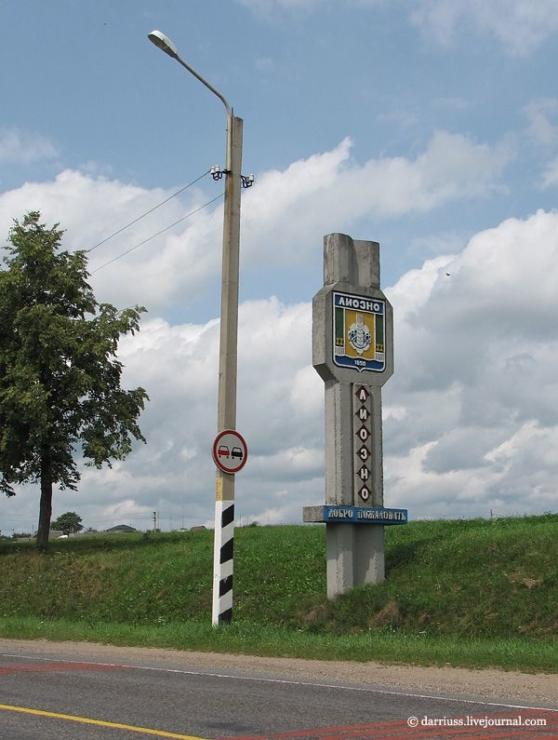


On the pillar at the entrance to the town where the Alter Rebbe lived it says: “Liozna – Welcome.”
4) Twice a week, on a set day and time, the men should engage in pilpul among themselves and each should present his questions and answers on the subject being learned. The Alter Rebbe appointed his brother R’ Mordechai over these discussion sessions.
5) Required to study halacha in groups in the same order as laid out for Gemara, no less than two hours a day and the study of Shulchan Aruch, one siman a day (a long siman to be learned over two days) according to the order of the four parts of Shulchan Aruch. The Alter Rebbe appointed his brother Maharil over the study of Shulchan Aruch.
The Rebbe Boosts The Students Of The Chadarim
As far as the inner dimension, pnimiyus ha’Torah, the students of the chadarim again received special attention. The Alter Rebbe would say special maamarei Chassidus for them. These teachings were called “Torah b’yachid” by the Chassidim, for in those days there were three ways that maamarei Chassidus were said:
1) Communal teachings – this occurred on Shabbos Mevorchim and Yomim Tovim.
2) Public teachings – once a month, sometimes twice a month, for the members of the chadarim and the yoshvim.
3) Private teachings – one or twice a month, usually on weekdays, only for those in the chadarim.
This is how it was for one year, apparently, from the middle of 5536 until the winter of 5537.
Due to the fact that at that time there was not yet a large number of Chassidim, the Rebbe maintained a closer relationship with the talmidim.
At the farbrengen on Shushan Purim 5700, the Rebbe Rayatz said that the Alter Rebbe would enter the Beis Medrash where the men and bachurim learned and now and then he would say an inspiring saying. Such a saying “opened a door from ‘chaya yechida’ to ‘nefesh ruach neshama’ and this saying did not just have a temporary effect but was engraved forever.”
One of the talmidim of the chadarim, Rabbi Moshe Vilenker, said that one day the Rebbe entered the beis medrash and sat on the southern (i.e. to the right of the Aron Kodesh) bench. After a short while he opened his eyes and said, “Shema Yisrael – a Jew feels.
“Bereishis – beis (i.e. two) reishis, for the Torah which is called reishis and for the Jewish people who are called reishis.
“Bara Elokim – for the purpose of making healthy (bari) the first tzimtzum. To reveal the intent of the name Elokim. That through avoda, the Infinite Light Blessed Be He before the tzimtzum will be drawn down.”
R’ Moshe said that this short saying gave inner chayus to the talmidim in their learning.
The Rebbe Left But The Chadarim Continued
For an entire year, the talmidim of the chadarim learned assiduously. However, after Pesach 5537, there was an “earthquake” in the court of Liozna. The Alter Rebbe wanted to leave Liozna for Eretz Yisrael together with his teacher-colleague, R’ Menachem Mendel of Horodok-Vitebsk.
The talmidim of the chadarim, who had begun to follow this new path, were devastated. They cried to the Alter Rebbe not to leave them. The Rebbe’s response was, “chayecha kodmin” (your own life comes first).
The Alter Rebbe prepared for the journey at the beginning of Iyar 5537. He was joined by his immediate family and his brothers, R’ Yehuda Leib, R’ Mordechai and R’ Moshe and their families. They were joined by about thirty talmidim of the chadarim who could not part from the Rebbe.
The Jews of Liozna, despite their being simple people, were G-d fearing and cherished bnei Torah. They greatly valued the good impression made by the talmidim of the chadarim and were very concerned about the dissolution of the chadarim after the Rebbe left Liozna. Thus, the local council of leadership called an emergency meeting at which it was decided:
1) All the homes of the Alter Rebbe and his brothers and their families would be held under the watch of the community until it would be seen whether they would return to their homes.
2) The community would support with room and board all the men and talmidim of the chadarim who wanted to remain in Liozna for a year.
3) The townspeople would commit to supporting fifty new bachurim who would come to learn in Liozna under the guidance of the men and talmidim of the chadarim.
The efforts of the town leaders made an impression on the Alter Rebbe. He knew they had an additional goal, that these men be husbands to their daughters. Therefore, the Rebbe told the talmidim of the chadarim and the Chassidim who remained in Liozna, to fulfill the request and to learn with the bachurim who would arrive. The Rebbe even set up a study schedule for them.
The day arrived and everyone in Liozna gathered in the yard of the large Beis Medrash; the bima used for the Torah reading was place in the yard. The Rebbe ascended the bima and blessed all members of the community and told them to support the bnei Torah and to cherish them; thus, they would merit sons and sons-in-law who were Torah scholars.
After the Alter Rebbe left, a large number of bachurim from the towns around Liozna came to learn Torah. The talmidim of the chadarim who remained in Liozna, who were already great scholars, devoted themselves to supervising the new bachurim and the sound of Torah and Chassidus grew.
Condition of Acceptance: Fuluency in Shas
Some time after he left on the journey, the Alter Rebbe arrived in Mohilev where he stayed for a brief period with R’ Menachem Mendel of Horodok and with R’ Avrohom of Kalisk.
At that time, delegations of Chassidim of the Alter Rebbe arrived and pleaded with him to remain with them despite his decision, and not to move to Eretz Yisrael. After much discussion, when R’ Menachem Mendel of Horodok also begged him to stay and take on the leadership, he finally decided to abandon his plan of moving to Eretz Yisrael and stayed in Russia.
In the meantime, his brothers, who had gone with him, hastily returned to Liozna where they discovered, to their surprise, groups of bachurim learning diligently with the talmidim of the chadarim guiding them.
The brothers reported that the Alter Rebbe planned on returning to Liozna for a short while and then he would decide where he would permanently reside. The Jews of Liozna wanted to do all in their power so that the Rebbe would remain with them permanently and decided to send a delegation to greet the Rebbe and beg him to remain with them. The delegation was augmented by the Rebbe’s brothers in order to bolster the seriousness of their request. The town leaders of Liozna committed to providing room and board to about a hundred men for a year. Aside from that, they committed to establish a hachnosas orchim for guests who came to the Rebbe’s court in Tishrei and other months of the year.
To their delight, the Rebbe said yes, and together with his family and talmidim who had joined him on the trip, they arrived in Liozna in Shevat 5538.
Upon arriving, a number of announcements were made in the name of the Rebbe in connection with talmidim of the chadarim:
-Men who wanted to come to receive guidance in learning would be tested in designated places.
-In the chadarim established in 5538 the conditions of acceptance to cheder alef were: fluency in Shas, Medrash, Sefer HaIkarim, Kuzari, and knowledge of Zohar.
Thus, the Rebbe established a new tier, which was far higher, for those whose souls yearned for Torah and wanted to learn Torah in his court under his personal supervision and guidance in a path to spiritual growth.
Hundreds of New Students
In the period that followed, the chadarim became known in all the cities and towns in the area. Young men came to Liozna from many locations in order to learn by the Rebbe. Due to the high demand, the Alter Rebbe established six cities from which future students of the chadarim would be picked: Liepli, Dubrovna, Smilian, Ulla, Shvintzyan and Yanovitch.
A representative of the Alter Rebbe would be in each of the places in order to test the candidates to see if they met the Rebbe’s criteria. Among the instructions were: in every test location there should be six or seven candidates and the test had to extend no less than two weeks! Only then could the appointee announce who would be accepted.
By request of the testers, the Alter Rebbe agreed that if there would be a good bachur who wanted to travel to Liozna but was not yet ready for that, they would be mekarev him and hand him over to the one of the young men who learned previously in Liozna and now lived in that city. Only after the bachur learned with a graduate of the cheder for a month or two would he be permitted to go to Liozna.
In the meantime, the Alter Rebbe arranged the talmidim of the chadarim, each in his place and what he should learn, according to his knowledge and attainments. At a later point, the Rebbe told his brother R’ Moshe to establish a shiur in Gemara with Rashi and Tosafos for bachurim who came to learn. The other two brothers supervised the men and their learning.
As mentioned, the talmidim of the chadarim came to learn for specific periods of time. When one group finished their session after a set number of months, they left Liozna and were replaced by other talmidim.
The demand to learn in Liozna grew and in the coming months four testing sites were added in Beshenkowitz, Keidan, Kletzk, and Mohilev. The testers would send continuous reports to the main rep, R’ Yehuda Leib.
The time spent by those outstanding Torah scholars in Liozna affected the entire town. The simple householders became ‘Zevuluns’ who took care of the men who learned, their young sons began to learn Torah diligently, and their daughters, who valued those who learned Torah, wanted to marry the bnei Torah.
Many local Jews decided to have their daughters marry students of the chadarim. In the summer months [apparently 5539], about forty weddings were held! These brides and grooms became the heads of the Chassidic families, bnei Torah and men of deeds in Liozna in the generations that followed.
The Rebbe Rayatz summed up what was happening in those years in the chadarim in a diary entry publicized in Sefer HaToldos Admor HaZaken:
“For these three years [5538-5540], the Alter Rebbe was successful, internally and outwardly. In Liozna there was a large number of men according to the regular schedule; the [operations] centers worked very diligently and in many towns, villages and communes, they placed rabbanim, shochtim and melamdim. That year, the Alter Rebbe already had several hundred talmidim from the men who sat in Liozna, from 5536 through and including 5540, along with the guests who came.”
In light of the great demand, the Alter Rebbe started additional chadarim, gimmel, dalet, and hei, in which men learned Nigleh and Chassidus and received guidance from the royal family of the Rebbe and his brothers. Many of the talmidim were eventually sent to various cities in order inspire other Jews to serve Hashem on a deeper lever, some of them were sent openly and some secretly so as not to arouse the ire of the Misnagdim.
The Early Greats from the Chadarim
The chadarim produced good fruit including some of the great Chassidim:
Reb Pinchas Reizes, who later became a chozer of the Alter Rebbe. At the start of his foray into Chabad Chassidus, he learned in cheder beis. The Rebbe Rayatz said that Reb Moshe Vilenker and Reb Pinchas Reizes, who were students of the first chadarim, said that at the beginning of their study track, shortly after the test, the Alter Rebbe sent them to Moshe Zalman Feldman for him to teach them niggunim.



Liozna today
The Chassid, Reb Yitzchok Isaac of Homil was also originally in the chadarim as the Rebbe Rayatz related: “When HaRav HaChassid, the gaon R’ Yitzchok Isaac of Homil came to the Alter Rebbe for the first time, he was accepted in cheder beis which the Alter Rebbe founded.
“The Chassid and gaon, Reb Moshe Meizlish was one of the Chassidim of cheder alef, over whom the Alter Rebbe was not as exacting as he was with the Chassidim of cheder beis.
“The Chassidim of cheder alef were supposed to be fluent in Shas, Tosafos, the Rosh and Rambam. When it came time to accept R’ Yitzchok Isaac of Homil, obviously he wasn’t lacking in fluency in Nigleh. When Maharil gave the results of the test to the Alter Rebbe, he asked him: What about the Ikarim, Kuzari, and Moreh Nevochim? The Alter Rebbe gave R’ Yitzchok Isaac five months to prepare for the test, noting that if he lacked knowledge in one of those sefarim he should ask Berel, i.e. the one who later became the Mittler Rebbe.”
Devotion for All
After all the descriptions of the chadarim, the obvious question arises: Is Chassidus and darchei ha’Chassidus only suitable for geniuses in Nigleh? What about simple Jews – are they not worthy of guidance and kiruv from the Alter Rebbe?
The simple answer is: the Alter Rebbe also paved a path in avodas Hashem for every Jew, even simple Jews, as the Rebbe Rayatz related:
“For twenty years, some of the talmidim of the chadarim worked on the deepest topics in Chassidus… During these twenty years, thousands of Chassidim were added to the ranks, including simple Jews who knew nothing beyond the words of the prayers, Tehillim and Chumash, not even the meaning of the words…
“When the Alter Rebbe started the chadarim and chose special students, great scholars who were gifted, this offended the average young men and simple householders as they thought they weren’t worthy. However, they were quickly shown their error. They were satisfied when they saw that the Alter Rebbe thought of their spiritual sustenance no less than he thought of the famous great talmidim who were geniuses.
“Since the Alter Rebbe was one of the great men of order, being gifted with the talent of imposing structure and anointed by Hashem from birth as a leader, he set down a certain order for the study of Torah and Chassidus in a way that every type of person, even the simplest, would find his proper place.”
*
The magazine can be obtained in stores around Crown Heights. To purchase a subscription, please go to: bmoshiach.org
123
Join ChabadInfo's News Roundup and alerts for the HOTTEST Chabad news and updates!




















